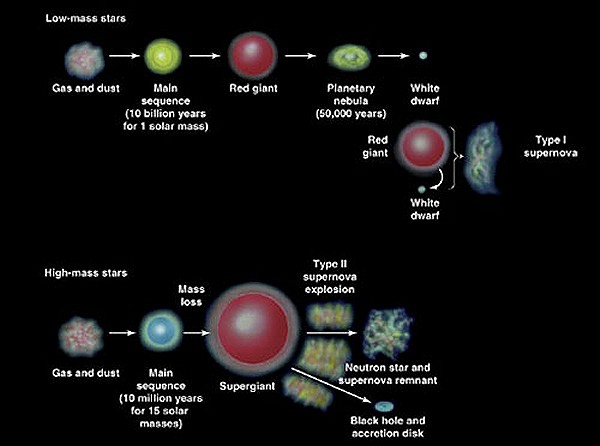|
There are several different main types of stars, depending on their size, luminosity and lifespan:
- Brown Dwarfs - "failed stars", which form from clouds of interstellar gas, as other stars do, but never reach sufficient mass, density and internal heat to start the nuclear fusion process (i.e. less than 8% of the mass of our Sun). Although they may glow dimly when newly formed (and are therefore in fact red not brown), they start to cool soon after and so are very difficult to spot. They may actually be among the most common type of stars.
- Red Dwarfs - small and relatively cool stars, bigger than brown dwarfs, but less than 40 - 50% of the mass of our Sun. Most of the stars in our galaxy (excluding possible unseen brown dwarfs) are red dwarfs. They are much dimmer than our Sun (even the largest red dwarf has only about 10% of the Sun's luminosity), burn much more slowly, and typically live much longer.
- Yellow Dwarfs - main-sequence stars like our own Sun, Alpha Centauri A, Tau Ceti, etc, typically about 80 - 100% of the size of the Sun, and actually more white than yellow. They are also known as G V stars for their spectral type G and luminosity class V.
- White Stars - bright, main-sequence stars with masses from 1.4 to 2.1 times the mass of the Sun and surface temperatures between 7,600°C and 10,000°C, such as Sirius A and Vega.
- Red Giants - luminous giant stars of low or intermediate mass (usually between 0.5 and 10 solar masses) in a late phase of stellar evolution, such as Aldeberan and Arcturus. When a main-sequence star has fused all its hydrogen into helium, it then starts to burn its helium to produce carbon and oxygen, and expands to many times its previous volume to become a red giant. After a relatively short time (in the region of two hundred million years), the red giant puffs out its outer layers in a gas cloud called a nebula and collapses in on itself to form a white dwarf. The largest red giants are known as red supergiants, and are the largest stars in the universe in terms of volume (well-known examples are Antares and Betelgeuse).
- White Dwarfs - small, dense, burnt-out husks of stars, no longer undergoing fusion reactions, and representing the final evolutionary state of most of the stars in our galaxy. When a red giant has used up its helium to produce carbon and oxygen, and has insufficient mass to generate the core temperatures required to fuse carbon, it sheds its outer layers to form a planetary nebula, and leaves behind an inert mass of carbon and oxygen. A white dwarf is typically only the size of the Earth, but 200,000 times more dense.
- Black Dwarfs - hypothetical stellar remnants created when a white dwarf becomes cool and dark after about ten billion years of life. Black dwarfs are very hard to detect, and very few would exist yet anyway in a universe only 13.7 billion years old.
- Blue Giants - bright, giant stars, between 10 and 100 times the size of the Sun, and between 10 and 1,000 times its luminosity. Because of their mass and hotness, they are relatively short-lived and quickly exhaust their hydrogen fuel, ending as red supergiants or neutron stars. The biggest and most luminous stars are referred to as blue supergiants and hypergiants. The best known blue supergiant is Rigel, the brightest star in the constellation of Orion, which has a mass about 20 times that of the Sun and a luminosity more than 60,000 times greater. The biggest and brightest ever found is 10 million times as bright as the Sun.
- Neutron Stars - stellar remnants that can result from the gravitational collapse of massive stars during a supernova event. They are composed almost entirely of crushed neutrons, and are very hot and very dense. Although a typical neutron star has a mass of only between 1.35 and about 2.1 times that of our Sun, it is 60,000 times smaller than the Sun (usually in the region of just 20 - 30 kilometers across) and, because of this huge density, has a gravity of over 200 billion times that we experience on Earth. They rotate very fast (especially soon after the supernova explosion) and some emit regular pulses of radiation and are known as pulsars. Smaller collapsed stars will usually become white dwarfs, and larger ones (over about 5 solar masses) will collapse completely into a black hole singularity.
- Variable Stars that grow and shrink in size periodically and appear to pulsate. The changes in apparent brightness may be due to variations in the star's actual luminosity, or to variations in the amount of the star's light that is blocked from reaching Earth.
- Binary Stars in close proximity which orbit around their common center of mass. In fact, the majority of stars are part of binary, triplet or multiple star systems, and well-known examples are Sirius in the Canis Major constellation and Alpha Centauri.
|

